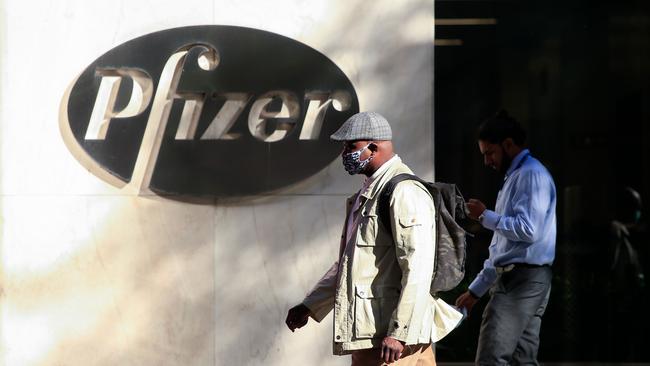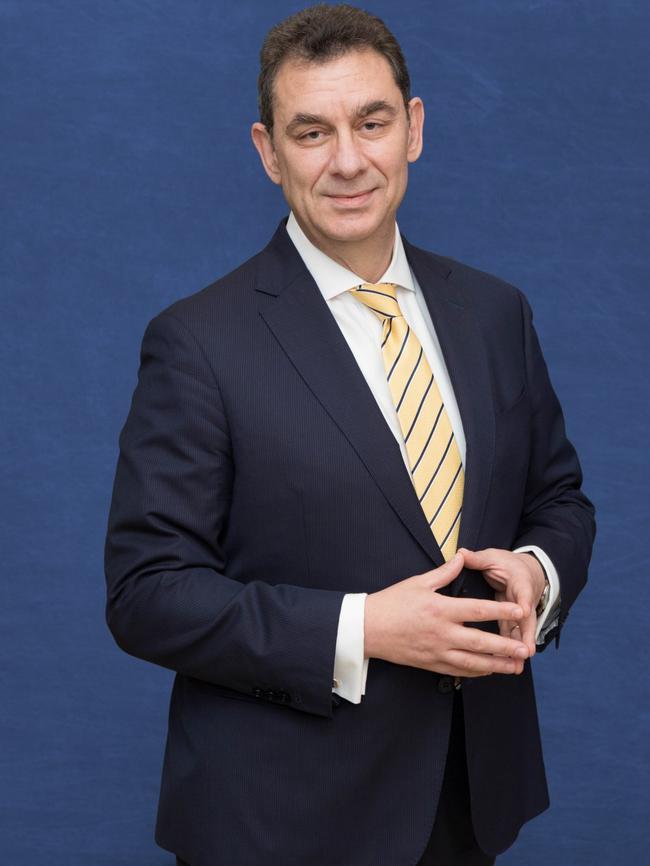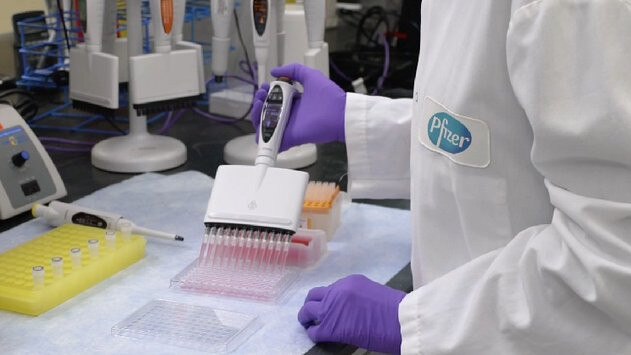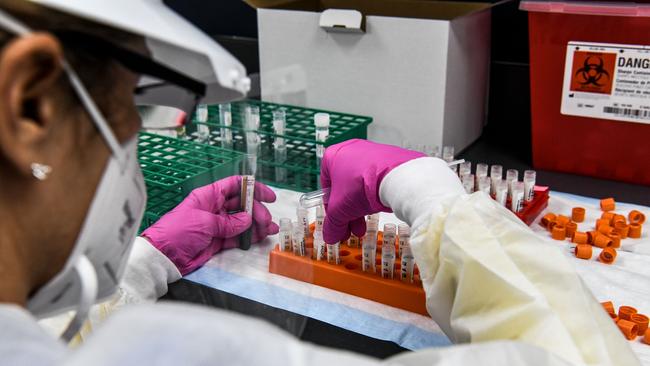How Pfizer delivered a Covid vaccine in record time: crazy deadlines, a pushy CEO
CEO Albert Bourla and his team overcame unproven science and manufacturing bottlenecks; ‘You’re asking for too much’

Pfizer Inc. was months from proving its COVID-19 vaccine would even work when Chief Executive Albert Bourla got into a tense WebEx debate with his head of manufacturing.
It was a warm day in June and Pfizer was racing to develop a radical new vaccine based on a technology that had never been approved before. Mr. Bourla and his team were so optimistic they had committed hundreds of millions of dollars to build a global manufacturing network.
Mr. Bourla, speaking from his suburban New York home during one of Pfizer’s twice-weekly meetings on the project, told the team he wanted them to increase commercial production at least 10-fold.
“Why can’t we make more and why can’t we make it sooner?” Mr. Bourla demanded. Mike McDermott, who oversees Pfizer’s global manufacturing network, pushed back. His team already was working furiously, he said.
“What we’re doing already is a miracle,” he said he told Mr. Bourla. “You’re asking for too much.” Even for jaded pharmaceutical scientists, what happened next was little short of miraculous. U.S. health regulators Friday night authorised the COVID-19 vaccine developed by Pfizer and its German partner BioNTech SE. The shot is already in U.K. use and will be the first given in the U.S., capping the fastest vaccine development ever in the West.
How the drugmakers pulled off the feat, cutting the typical time from more than 10 years to under one, partly stems from their bet on the gene-based technology.
As the inside story shows, it was also the product of demanding leadership, which bordered on the unreasonable. From urging vaccine researchers to move fast to pressing the manufacturing staff to ramp up, Mr. Bourla pushed employees to go beyond even their own ambitious goals to meet COVID-19’s challenge.
Pfizer couldn’t meet every target set by its chief executive. Mr. Bourla wanted the vaccine done by October and as many as 100 million doses by year’s close, enough for 50 million people. Instead about half that will be produced.

Yet the company, which has spent more than $2 billion on the effort, achieved more, faster, than outside experts and even its employees thought possible. In a series of interviews over more than seven months, senior Pfizer executives and other managers shed new light on how the vaccine project took shape.
Early in the pandemic, U.S. health officials cautioned the first vaccines wouldn’t be ready until 2021. Pfizer’s vaccine researchers initially forecast the middle of next year at the earliest.
Previously, the quickest vaccine development program was the four years it took to make the mumps vaccine, licensed in 1967. After getting Mr. Bourla’s go-ahead, Pfizer researchers figured they could shorten the timeline to a year, give or take.
Crucial to what they considered an ambitious forecast: the unproven gene-based technology honed by BioNTech, a small biotech company based in Mainz, Germany, already in partnership with the big drugmaker to develop a flu shot.
BioNTech wanted to make vaccines out of messenger RNA, or mRNA, the molecules that carry genetic instructions telling cells what proteins to make.
The German company’s researchers thought they could use the genetic sequence of the coronavirus, which had recently been published, to synthesise mRNA that would instruct cells to make a harmless version of the spike protein that protrudes from the surface of the virus.
The defanged spike proteins would prompt a person’s immune system to produce antibodies that could fight off the real virus.
Unlike the months it takes to cultivate a vaccine in test tubes, designing an mRNA vaccine would be quick. BioNTech simply plugged the genetic code for the spike protein into its software. On Jan. 25, BioNTech Chief Executive Ugur Sahin designed 10 candidates himself.
The company’s researchers would create 10 more different potential coronavirus vaccines for a total of 20, each slightly different in the event one design worked better and more safely than the others.
But BioNTech, founded in 2008 and with just 1,000 employees when the pandemic hit, needed a big partner to manufacture the vaccines for human trials and potentially for people around the world.

During a March 1 phone call, Dr. Sahin proposed a coronavirus vaccine collaboration with Kathrin Jansen, Pfizer’s vaccine-research chief.
Many in pharma were sceptical of mRNA, which had been long in the making but never the basis for an approved product. Dr. Jansen, known in the industry for helping develop Merck & Co’s cervical-cancer shot Gardasil, saw promise, in large part because mRNA vaccines appeared to produce stronger immune responses than older shots.
“This is a disaster, and it’s getting worse,” Dr. Jansen told Dr. Sahin. “Happy to work with you.” Mr. Bourla gave his go-ahead a week later, at one of Pfizer’s first leadership meetings on the program. When vaccine researchers at a follow-up meeting in mid-March forecast a coronavirus vaccine in the middle of 2021, Mr. Bourla spoke up.
“Sorry, this will not work,” he said. “People are dying.” Mr. Bourla demanded a vaccine by October, when it looked like a second wave of the pandemic would be peaking.
Growing up in Greece, Mr. Bourla never envisioned a career running one of the world’s biggest drugmakers. He trained to be a veterinarian. At Pfizer, Mr. Bourla gained a reputation for his friendliness and achievements, brightly chatting up colleagues and rescuing troubled products. He took the helm of Pfizer in 2019.
“I’m a true believer that people, they don’t really know their limits,” Mr. Bourla said in an interview. “And usually, they have the tendency to underestimate what they can produce.” Pfizer’s leadership held hour-long meetings Mondays and Thursdays on the vaccine program. The WebEx calls lacked a formal agenda so that discussions could flow freely. Dr. Jansen and the two dozen other colleagues who joined grew accustomed to Mr. Bourla urging fast progress.
Pfizer and BioNTech researchers collaborating via video sought to narrow down the number of vaccine candidates from 20. In test tubes, they examined various doses and looked for molecular signs of effectiveness and safety. BioNTech also tested the candidates in mice.
The whittling was especially tough, because mRNA vaccines weren’t tried-and-true commodities. Researchers wanted to collect as much data as they could to inform their judgments. They also had to move fast.
Vaccines normally are tested in three stages, with the first test on a limited number of people to ensure they are safe. To save time, the researchers took unorthodox steps. In April, they filed their plans for testing a candidate with regulators, but the paperwork was littered with holes for data they would need to fill in. Pfizer also combined the second and third stages. And then they decided they should test more than one version of the vaccine. The company sent the U.S. Food and Drug Administration updated batches of data almost daily.
By April 12, the scientists eliminated 16 candidates. They didn’t know how to choose among the remaining four. Normally, researchers would take years and finish animal testing before injecting any doses into a human. Pfizer didn’t have that kind of time. It still tested the vaccines in monkeys, but simultaneously with humans. “We needed speed, and with speed, you have to rethink how you normally go,” said Dr. Jansen, who leads a team of 650.
On April 23, they started trying the four candidates on a small number of human volunteers in Germany. Within two days of getting two of the shots, some subjects developed fevers and chills, signs the vaccines wouldn’t be well tolerated.
The companies went ahead with testing the other two experimental vaccines in the U.S. One directed cells to produce a partial-spike protein, while the other generated a full-spike protein. Researchers tested different doses and determined either version would require two shots to deliver maximum immunity.
On Sunday, June 7, researchers emailed Dr. Jansen the first results from the early-stage trial of the first vaccine candidate. Dr. Jansen, preparing a presentation in her Manhattan apartment, brightened.
The findings showed the experimental shot produced an antibody response in study subjects, a good sign it could protect against COVID-19.
“Really, really encouraging,” she replied to the researchers by email. “When can I see the next data?” Pfizer announced the full findings July 1. The second, or full-spike, candidate wouldn’t finish its own study for a few weeks. Without that data, the companies weren’t sure which of the two to take into the large, final trial that regulators would use to determine whether to authorise the shot or not.
Most of the results didn’t arrive until July 23, the day before Pfizer told the FDA it would name a candidate.
Like its cousin, the second candidate also generated a strong immune response. Yet subjects reported fewer cases of fevers and chills than the first vaccine candidate, so it was considered more tolerable.

The choice was tough because the candidates were so close, Pfizer officials said. On July 24, Pfizer and BioNTech agreed to go with the second vaccine candidate.
“I started to relax a little bit, which I haven’t really done since the beginning of all of this.” Dr. Jansen recalled a week later. “It is just a major, major, major decision to make.” As the researchers zeroed in on a vaccine selection, Pfizer’s manufacturing team geared up to make the shots with BioNTech. Given the urgent need for a vaccine, the companies planned to make supplies for testing, but also to begin making vaccines for real-world use even before the final study finished.
One problem: Pfizer didn’t have the equipment to make an mRNA vaccine, a new and different manufacturing process.
To assemble its mRNA production network, Pfizer used its own money and didn’t take any from the federal government. Executives said they didn’t want to give agencies outside the FDA more leverage over the design of the trials.
Rival Moderna, which took funding from a division of the U.S. Department of Health and Human Services, suffered a three-week delay in completing its own mRNA trial after federal officials there asked the company to slow down enrolment to boost the racial and ethnic diversity of study subjects.
Starting in March, Mr. McDermott spent $500 million to buy and design equipment, more than double what he budgeted. Pfizer retrofitted an Andover, Mass., plant to make the mRNA, and assigned a St. Louis factory to make the raw materials for the shots. Numerous times it returned to suppliers or contractors to increase orders.
Instead of making mRNA in giant steel tanks, which would add months, Pfizer used disposable bags. Each fits at least 500,000 doses.
In April, the company began buying machines the size of a single-car garage that play a crucial role in production. These formulation machines deposit the mRNA vaccine in the fatty, or lipid, envelope that carries it to a cellular target. Without the safe passage, the vaccine breaks down during the journey.
Pfizer bought seven of the machines, each costing $200 million, destined for company plants in Puurs, Belgium, and Kalamazoo, Mich. It takes about a week to make a batch of doses, which then undergo two weeks of testing. The finished product is stored at subzero temperatures to stay stable and potent.
Mr. McDermott and his team took steps to maximise output. Companies typically put one vaccine dose in a single vial so a nurse doesn’t need to draw out and measure how much to inject. Pfizer went with vials capable of holding multiple doses, because filling them was faster.
Demands for doses kept increasing, sometimes frustrating Mr. McDermott. He was a 30-year industry veteran who became part of Pfizer in 2009, and has years of experience making vaccines such as the pneumonia shot Prevnar. A hands-on engineer, he likes crawling under the machinery for a look.
Then on June 30, regulators in the U.S. and Europe said they wanted the late-stage trials to have far more subjects than initially anticipated — 30,000 rather than 8,000.
That meant Pfizer and BioNTech would have to make triple the dose supplies it had planned — within weeks. And Mr. McDermott’s vaccine-research counterparts hadn’t settled on a final candidate, which meant the company would have to make materials for two candidates.
“It was like, ‘Oh, my God, we can’t do this,’ ” Mr. McDermott said, recalling his reaction.
Within a day, he and one of his deputies, Kevin Nepveux, got a call from their Belgian plant. Engineers would speed up preparation of filling lines to make more trial doses. They also figured out how to squeeze another formulation machine into the facility, helping make commercial doses six months earlier.
It wouldn’t be cheap. Mr. McDermott, working out of his New Jersey home office, rang up Pfizer Chief Financial Officer Frank D’Amelio. “I got an idea, and I need $10 million. Is it an issue?” Mr. McDermott said.
“Just do it,” Mr. D’Amelio said.
Pfizer wasn’t sure how long doses would last in a refrigerator before expiring, and the company didn’t have time to conduct studies to figure it out. Manufacturing staff decided to play it safe and ship the supplies at subarctic temperatures.
In April, Pfizer started working with contractors to create a container to keep the shots cold. The suitcase-size box could hold nearly 5,000 doses. To test it, the company ferried containers on hundreds of trips around the world, visiting Dubai, Africa, and even the doorsteps of Pfizer employees.
Mr. Nepveux’s grown son was visiting his parents’ New Jersey home when a package arrived. “When it got delivered, he thought it was some kind of fancy beer cooler,” Mr. Nepveux said.
Just before the July 4 weekend, Mr. McDermott’s team showed off the container to colleagues. The team was excited because of the quick turnaround. Then came Mr. Bourla’s reaction.
“What in the hell is CVS going to do with 5,000 doses?” he said. Pharmacies run by CVS Health Corp. and doctor’s offices, he said, would need to receive fewer doses.
Mr. McDermott’s team went back to the drawing board. Pfizer now plans to release a 25-vial, or 125-dose, package next year.
The decision to go ahead with the second vaccine candidate, made at the end of the month, was another shock. While colleagues on the call cheered the milestone, Mr. McDermott did some math in his head and groaned.
His team had anticipated the first candidate would be the choice. The second one required a larger dosage, which meant fewer shots could be packed in a vial.
By that point, Pfizer was targeting as many as 100 million doses for 2020. Mr. McDermott asked whether they could toggle back to 80 million. Mr. Bourla wouldn’t relent. “Find a way,” he said.
The late-stage trial, cleared to start on July 27, began quickly. Within hours, the first four healthy volunteers received injections at the University of Rochester Medical Center in upstate New York.
Evaluating whether the experimental shot protected against COVID-19 meant finding people for the trials in places where a study subject had a good chance of getting exposed. Then researchers could see if they developed symptoms or not, and whether they had taken the vaccine or placebo.
The company deployed mathematical models that crunched infection rates down to zip codes, to identify hot spots.
Researchers hoped the seriousness of the disease would encourage people to sign up. Some 20,000 enrolled through August. By the end of the month, however, enrolment had veered off track.
There were two problems. People weren’t signing up in target areas as fast as the companies expected. And the mathematical models weren’t doing a good job at predicting virus hot spots more than a few weeks out.
The virus had shifted to other places by the time subjects had joined the pivotal study and taken both shots. Due to local efforts to curb the pandemic, infection rates were falling in places like New York and Washington state where researchers had been recruiting.
“It is like a puzzle, and the puzzle is changing,” Dr. Jansen said. Dr. Jansen convened researchers and computer scientists on Sept. 1 to review the virus’s behaviour and make changes to the trial.
Within days, researchers stopped enrolling patients at certain sites, including in New York City. They upped the recruitment goals in emerging hot spots such as Argentina. They also expanded the trial by 14,000 subjects to increase the odds of exposure.
Still, by early October, fewer subjects than expected had become sick. Pfizer scientists were perplexed. Perhaps study subjects were taking precautions to stay healthy, such as wearing masks and social distancing, the researchers theorised. Maybe the FDA-authorised tests Pfizer was using to confirm cases weren’t accurate, Dr. Jansen said.
Pfizer stopped processing test results and asked the FDA to permit use of a different test. The FDA, meanwhile, wanted Pfizer to wait until 64 subjects became sick before taking its first peek, rather than just 32, as the company had planned.
By the time the two sides struck an agreement in early November, the issue was moot: 94 people had become sick, triggering a preliminary review that found the vaccine was more than 90% effective and looking safe.
Mr. Bourla learned the results Sunday afternoon. When he gave the findings to senior company officials on a call, Mr. Bourla said people jumped up from their chairs.
To get a head start building up supplies, in mid-August the company began producing doses at its Belgium factory that could go immediately into use should any country give clearance.
By the end of September, the company had set aside 1.5 million doses to be frozen and ready to ship.
Yet most of Pfizer’s manufacturing network wouldn’t be ready for making shots until October. Installing, testing and certifying the machines made supplies correctly took weeks, culminating in engineering runs in September.
Looking for workarounds, Mr. McDermott tweaked the production process in a way he figured would add 5 million more doses a week. But in the end, despite making enough mRNA for 100 million doses, Pfizer and its partners incurred a three-week delay securing enough raw materials to make the lipid nanoparticle that wraps around the vaccine. On Nov. 9, Pfizer disclosed it would make 50 million doses this year, half what Mr. Bourla wanted.
Still, the chief executive is looking on the bright side. “I always try to shoot for the stars, because I know that even if you miss it, you will land somewhere in the moon,” he said. “But right now it looks like we landed, more or less, in the stars.”
Peter Loftus contributed to this article.
The Wall Street Journal



To join the conversation, please log in. Don't have an account? Register
Join the conversation, you are commenting as Logout